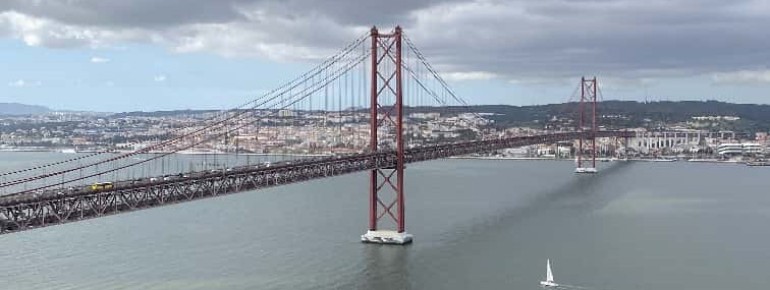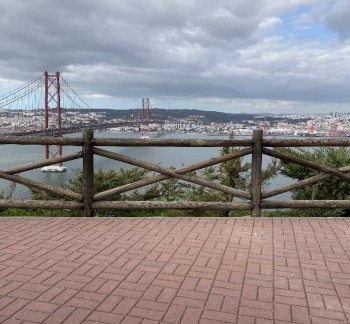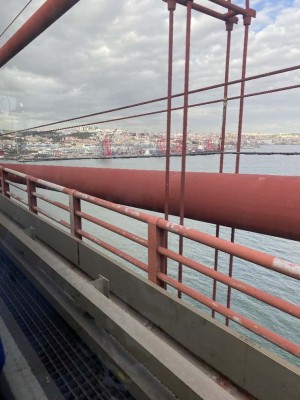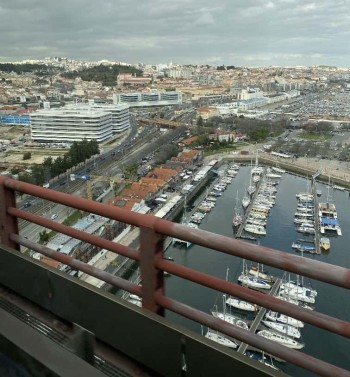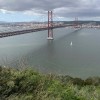Contents
Description
The Ponte 25 de Abril is not only one of the longest suspension bridges in Europe, but also a fascinating landmark for anyone interested in engineering and eventful history. With its bright red color, it spans the Tagus River majestically, connecting Lisbon's Alcântara district with the southern city of Almada. The 2,278-meter-long suspension bridge with its 190-meter-high main pillars dominates the cityscape and offers spectacular photo opportunities from numerous vantage points.
Architectural masterpiece
Completed in 1966, the bridge is an impressive example of modern engineering. With a main span of 1,013 meters, it is one of the largest suspension bridges of its kind in Europe. The two suspension cables each have a diameter of 58.6 centimeters, and the total length of the wires used is 54,196 kilometers – more than the circumference of the Earth at the equator. The structure was designed to be earthquake-proof and must withstand strong winds and salty sea air. At a height of 70 meters above the water, the bridge also allows large ships to pass through. The striking red color is regularly renewed to protect the steel structure from corrosion.
Double-decker transport link
The Ponte 25 de Abril is one of the few suspension bridges of this size in the world that carries both road and rail traffic. The upper level carries six lanes of the A2 motorway, while a double-track railway line was installed on the lower level in 1999. An average of 150,000 vehicles and 160 trains cross the bridge every day – a total of around 390,000 people use this important link every day.
Experiência Pilar 7
Since 2017, the interactive exhibition “Experiência Pilar 7” has been offering visitors a unique insight into the bridge. The attraction on Avenida da Índia guides visitors through the history of the bridge's construction with multimedia installations, historical photos, and detailed models. The highlight is a ride in a glass elevator to an 80-meter-high viewing platform directly on the seventh bridge pier, from where visitors can enjoy a breathtaking view of the Tagus River, Lisbon, and the Cristo Rei statue on the opposite side. For the brave, there is a glass floor that promises additional thrills. Virtual reality simulations allow visitors to explore normally inaccessible areas of the bridge virtually.
Symbol of democracy
The bridge bears its name in memory of the peaceful Carnation Revolution of April 25, 1974, which marked the end of the Portuguese dictatorship. Originally named “Ponte Salazar” after the dictator, it was renamed immediately after the revolution. During the uprising, the bridge even played a strategic role: revolutionaries blocked it for several days, preventing loyalist troops from the south from intervening. Today, it is a symbol of freedom and democratic triumph, which is particularly evident during the celebrations on the national holiday, April 25.
Similarity to the Golden Gate Bridge
At first glance, the Ponte 25 de Abril is strongly reminiscent of the Golden Gate Bridge in San Francisco – and that is no coincidence. The bridge was built by the American Bridge Company, which was also involved in the San Francisco-Oakland Bay Bridge. The steel was imported from the USA, and the characteristic red color reinforces the visual similarity. One difference, however, is in the pylons: while the Golden Gate Bridge has horizontal crossbars, the struts of the Ponte 25 de Abril are diagonally crossed.
The Lisbon Half Marathon
Once a year in March, the bridge is transformed into a running track: During the Lisbon Half Marathon, which has started on the Ponte 25 de Abril since 1991, runners and walkers have the unique opportunity to cross the bridge on foot – otherwise it is not accessible to pedestrians. From the middle of the roadway, spectacular views of the steel structure and the surrounding panorama open up.
Historical Information
The Ponte 25 de Abril has its roots in the Estado Novo regime under dictator António de Oliveira Salazar. Plans to build a bridge across the Tagus River were first considered in the late 19th century, but it was not until 1953 that concrete plans were drawn up. In 1960, the government awarded the contract to the American Bridge Company, and construction began on November 5, 1962. After only 45 months of construction, the bridge was inaugurated on August 6, 1966, in the presence of top government officials as the “Ponte Salazar” – at that time the longest suspension bridge in Europe. After the peaceful Carnation Revolution of April 25, 1974, it was immediately renamed. Between 1996 and 1999, an extensive expansion took place: the bridge was given additional suspension cables, two additional lanes, and a completely new railway deck under the original roadway. This modernization made it one of the few suspension bridges in the world that carries heavy rail traffic.
How to get there
By car
The bridge can be reached via the A2 motorway. There is a toll charge for cars entering Lisbon (towards the city center). The exit is free of charge.
By public transport
To get to Experiência Pilar 7 from Lisbon, take tram 15E to the “Calvário” stop or take the suburban train from Cais do Sodré station towards Cascais to Belém station. From there, it is a few minutes' walk to the attraction on Avenida da Índia.

